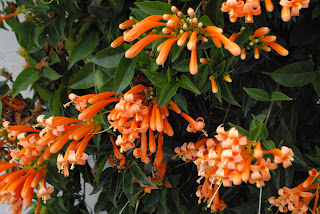Barro Colorado Island is an island within the Panama Canal. The damming of the Chagres River (1907-1913) caused the flooding of a large area, including the formation of Lake Gatun--the largest lake in Panama (at the time the dam was built, it was the largest dam, and the lake was the largest man-made lake)--and separated Barro Colorado Island (BCI) from the mainland. The island was protected as a reserve starting in 1923, and has been administered by the Smithsonian since 1946. This has provided a long history for scientific study, and is particularly useful due to it's relative isolation (due to being an island...though apparently puma's swim over sometimes...) and limited area (15.6 square-kilometers or 6 square-miles). In addition the history of research informs and enables further research, as is often the case. Yesterday we had the opportunity to take a guided tour of BCI. Here's the rundown of what we saw.
Two poison dart frogs (they hopped pretty fast, though, so all my pictures are blurry), a large katydid (a type of grasshopper)...
...several tiny frogs including this one (they're all over the place once you start looking...usually you don't see them until they move though),
...a deposit of red-eyed tree frog (
Agalychnis callidryas) eggs...
 |
| Don't they look bizarre? |
...lots of the golden silk orb-weaver spiders (genus Nephila), including some webs across the trail and only narrowly avoided...
...a crested guan (Penelope purpurascens), a large bird with a striking red dewlap...
...a small colony of greater sac-winged bats (Saccopteryx bilineata)...
...a trogon...
...a caiman...
 |
| Seen right next to the ferry dock. |
...and a green vine snake (Oxybelis fulgidus). Can you find it?
So now that I (hopefully) have you interested in the fauna, let me tell you about some of the funky flora. You may have noticed that I keep mentioning these things called lianas. Lianas are woody vines and are very common in tropical rainforests. Some common temperate plants, however, are also lianas, such as certain clematises and wild grapes. Lianas in the tropics, however, are often much more abundant and larger, and can even compete with trees. This only happens in the tropics because for lianas to grow that tall they need to have large vessels in their xylem to transport water through their entire length, but in temperate areas these large vessels freeze, causing embolisms. Smaller xylem vessels, however, can be better protected from the negative effects of freezing. Lianas are very strong, as seen here, where the tree trunk has grown after the liana grew around it, leaving scars.

Most lianas have wind-dispersed seeds, but this species has very large fruit which drop to the ground around it.
What's interesting about this is that no animals eat the fruit and disperse the seeds, which means all the seedlings are in competition. Not only is this an abnormal state of affairs for plants, but if the seeds were supposed to just drop to the ground, why expend the energy and resources to produce such large fruit? One hypothesis for why this might be is that this species coevolved with now extinct megafauna (think mastodons and gomphotheres) which would have dispersed its seeds.
Perhaps the most impressive sight of the day was a tree of the species Ceiba pentandra. Apparently the Maya considered it sacred, and you can see why. This particular tree is over 500 years old.
Maybe that looks normal to you? Think again...
 |
| (Thanks to Lee for taking this picture for me!) |
_med.JPG)
_med.JPG)
_med.JPG)




_med.JPG)
_med.JPG)











_med.JPG)
_med.JPG)
_med.JPG)
_med.JPG)









_med.JPG)

_med.JPG)
_med.JPG)
_med.JPG)










_med.JPG)



